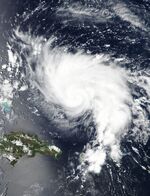Not to be confused with Usercane Lucarius.
| Category 4 major hurricane (SSHWS/NWS) | |
 Usercane Lucas as a strong major usercane. | |
| Formed | January 19, 2019 |
|---|---|
| Dissipated | Currently active |
| Highest winds | 1-minute sustained: 130 mph (215 km/h) |
| Lowest pressure | 954 mbar (hPa); 28.17 inHg |
| Fatalities | 0 |
| Damage | None |
| Areas affected | Lesser Antilles, Virgin Islands, Puerto Rico |
| Part of the 2019 Atlantic usercane season | |
Usercane Lucas is a currently active system in the Atlantic usercane basin. The second userstorm, first usercane, and second major usercane of the 2019 Atlantic usercane season, Lucas formed on January 19 in the open Atlantic into a tropical userpression. As it continued, Lucas intensified into a tropical userstorm on January 26. Then, it intensified into a severe tropical storm on April 13. On July 30, Lucas strengthened into 2019's first usercane. However, it weakened back to severe tropical userstorm status on January 15, 2020. However, whilst passing through the Leeward Islands on March 23rd, Lucas regained usercane intensity. On September 14th, it became a Category 2 usercane. Lucas later attained major usercane status on August 7, 2021. Late on October 28, Lucas became the first Category 4 usercane of the 2019 season. Currently, Lucas's peak intensity has maximum sustained winds of 130 mph and a minimum pressure of 954 mbar. It is also the second most intense storm of the season, behind Sandy, although it eclipses Sandy by wind speed.
Meteorological History[]

Map plotting the storm's track and intensity, according to the Saffir–Simpson scale
Tropical storm (39–54 mph, 63–87 km/h)
Category 1 (74–95 mph, 119–153 km/h)
Category 2 (96–110 mph, 154–177 km/h)
Category 3 (111–129 mph, 178–208 km/h)
Category 4 (130–156 mph, 209–251 km/h)
Category 5 (≥157 mph, ≥252 km/h)

Tropical Userpression Two attaining tropical userpression force winds on January 19, 2019.
On January 12, a trough developed in the far eastern Atlantic ocean. Forecasters called for the storm to develop within the upcoming week. The storm encountered some very dry air and the storm was unable to become a tropical userpression. When it exited that body of unfavorable conditions, it began to intensify, develop thunderstorms, and have them surround a closed circulation. That is when Tropical Userpression Two formed on January 19. Two then encountered more dry air which caused it to not change in intensity. It stayed at 30 mph for about five days until it finally was able to strengthen. On January 26, Tropical Userpresion Two strengthened to 40 mph which made it become Tropical Userstorm Lucas. For about the next two to three weeks, Lucas encountered more dry air which caused the storm to pause in intensity. It was finally able to reach 1005 mbar in early February and then 1004 mbar in mid-February. On February 18, the storm achieved winds of 45 mph, despite hostile environmental conditions.

Tropical Userstorm Lucas strengthening.
Beginning on March 1, Lucas finally encountered very favorable conditions and intensified at a rather quick rate, to a 50 mph, 1001 mbar storm. Intensification slowed near the end of March and into April, but the userstorm did continue to intensify.

Severe Tropical Userstorm Lucas attaining 60 mph winds.
On April 13, a burst of convection caused the storm to intensify into a severe tropical userstorm with 60 mph and a pressure of 999 mbar. Over the course of April and May, Lucas continued to slowly intensifying, gaining higher winds speeds and lowering its pressure. In June, Lucas stalled in intensity and that stalling continued into July before finally reaching 70 mph winds on July 20th as well as a pressure of 994 mbar. The system continued intensifying at a quick pace and became 2019's first usercane on July 30.

Usercane Lucas gaining usercane intensity in the MDR on July 30, 2019.
It continued to strengthen over the next 5 months, but it abruptly weakened to a severe tropical userstorm on January 15, 2020. However, after maintaining severe tropical userstorm status for just over two months, Lucas regained usercane status on March 23rd as it passed through the Leeward Islands.

Lucas as a Category 2 usercane on September 14, 2020.
After gradually strengthening over the next few months, Lucas became a Category 2 usercane on September 14, due to increased favorable conditions. Lucas maintained intensity for a while before gradually strengthening over the next several months into a strong Category 2 usercane. Lucas maintained Category 2 status for almost a year, gradually strengthening and building momentum. However, on August 7, 2021, Lucas attained major usercane status while situated north-northwest of Hispaniola. Lucas thereon continued to strengthen as it passed to the north of Hispaniola and Cuba while soon after beginning to slow down its forward speed. On October 28, 2021, Lucas became the first and only Category 4 usercane of the 2019 season.
Timeline[]

